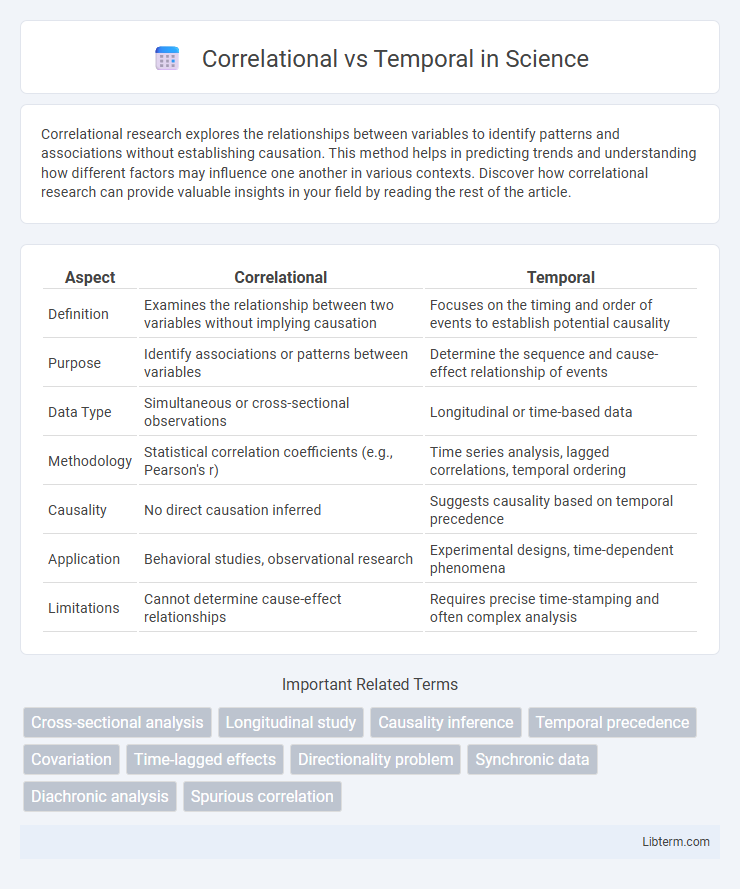Correlational research explores the relationships between variables to identify patterns and associations without establishing causation. This method helps in predicting trends and understanding how different factors may influence one another in various contexts. Discover how correlational research can provide valuable insights in your field by reading the rest of the article.
Table of Comparison
| Aspect | Correlational | Temporal |
|---|---|---|
| Definition | Examines the relationship between two variables without implying causation | Focuses on the timing and order of events to establish potential causality |
| Purpose | Identify associations or patterns between variables | Determine the sequence and cause-effect relationship of events |
| Data Type | Simultaneous or cross-sectional observations | Longitudinal or time-based data |
| Methodology | Statistical correlation coefficients (e.g., Pearson's r) | Time series analysis, lagged correlations, temporal ordering |
| Causality | No direct causation inferred | Suggests causality based on temporal precedence |
| Application | Behavioral studies, observational research | Experimental designs, time-dependent phenomena |
| Limitations | Cannot determine cause-effect relationships | Requires precise time-stamping and often complex analysis |
Introduction to Correlational and Temporal Analysis
Correlational analysis examines the statistical relationship between two or more variables, identifying patterns and strength of associations without implying causation. Temporal analysis explores data across time sequences, emphasizing trends, patterns, and changes within time-based datasets to understand dynamic processes. Both methods provide critical insights for data interpretation, with correlational focusing on variable interdependence and temporal highlighting the dimension of time.
Defining Correlational Relationships
Correlational relationships describe the statistical association between two or more variables, indicating how closely their values change together without implying causation. These relationships are measured using correlation coefficients, such as Pearson's r, which quantify the strength and direction of the association. Understanding correlational relationships is essential for identifying potential patterns and connections in data before exploring causal or temporal dynamics.
Understanding Temporal Relationships
Temporal relationships reveal the sequence and timing of events, crucial for distinguishing cause-and-effect patterns over mere correlations. Understanding temporal dynamics enables accurate identification of how one event influences another across time, providing deeper insights than correlational analysis alone. Leveraging precise temporal data ensures better prediction models and decision-making in fields like epidemiology, finance, and social sciences.
Key Differences Between Correlational and Temporal Methods
Correlational methods identify relationships between variables without implying causation, focusing on measuring the strength and direction of associations using statistical metrics like Pearson's r. Temporal methods examine causal links by analyzing the timing and sequence of events, often utilizing time-series data or longitudinal studies to establish cause-and-effect dynamics. Key differences lie in correlation describing systematic co-variation and temporal methods emphasizing temporal precedence and causality in data interpretation.
Importance of Directionality in Temporal Analysis
Directionality in temporal analysis is crucial for establishing causality and understanding the sequence of events over time. Unlike correlational studies that identify relationships between variables without specifying cause and effect, temporal analysis emphasizes the order and timing, which allows for accurate predictions and interventions. Recognizing the direction of influence helps prevent erroneous conclusions and supports more effective decision-making in fields such as epidemiology, economics, and behavioral science.
Common Applications in Research and Data Science
Correlational analysis is extensively used in research fields such as psychology, marketing, and social sciences to identify relationships between variables without implying causation. Temporal analysis is crucial in time series forecasting, finance, and epidemiology to assess how data points evolve over time and detect patterns or trends. Data scientists frequently combine correlational and temporal methods to enhance predictive modeling, anomaly detection, and causal inference in complex datasets.
Limitations of Correlational Analysis
Correlational analysis reveals relationships between variables but cannot establish causation, limiting its utility in understanding temporal dynamics. It fails to account for the directionality of effects, making it difficult to determine which variable influences the other over time. Confounding variables and the absence of temporal sequencing further restrict correlational analysis from providing definitive insights into causal mechanisms.
Challenges in Temporal Analysis
Temporal analysis faces challenges such as handling irregular time intervals, managing data gaps, and addressing time-dependent confounding factors that obscure causal relationships. Distinguishing correlation from causation requires sophisticated models like Granger causality and time-series decomposition to interpret temporal dependencies accurately. Accurately capturing dynamic patterns demands extensive data preprocessing and advanced algorithms to prevent misleading conclusions in sequential datasets.
Selecting the Right Approach for Your Study
Selecting the right approach between correlational and temporal methods depends on the study's objective and data characteristics. Correlational studies identify relationships and patterns between variables without implying causation, ideal for exploratory research or when manipulation is not possible. Temporal approaches analyze sequences and timing of events to uncover causal links and dynamics, best suited for studies aiming to establish cause-effect relationships over time.
Conclusion: Integrating Correlational and Temporal Insights
Combining correlational and temporal analyses enhances understanding by revealing both relationships and their directionality over time, which aids in identifying causal pathways and dynamic processes. Integrating these insights supports more accurate predictions and effective interventions across fields such as psychology, medicine, and economics. This holistic approach leverages the strengths of each method to provide a comprehensive view of complex phenomena.
Correlational Infographic

 libterm.com
libterm.com